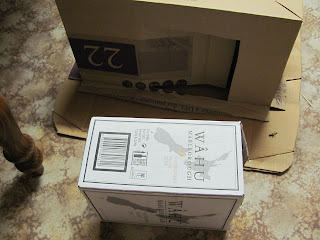One thing to bear in mind is this - the bigger the base the thicker it needs to be. In the case of this castle the base will be around 75cm (2.5') in width and around 90cm (3') in depth. This means that it is in no way suitable to use only a single layer of cardboard as it would flex/bend too easily and wouldn't be sturdy enough. To make a solid base I'm going to use 3 layers in a lattice pattern. This makes it extra strong, in fact many times stronger than a single piece of cardboard as thick as the 3 layers of the cardboard I'm using combined.

Above: I'm using some pretty big boxes made from thick card to make this base - leftovers of some electrical items that I bought.
Below: When I say to lay it in a lattice pattern I mean that you should alternate the direction of each layer when you glue them together. You can see the 'grain' of the corrugated cardboard runs in two directions. In corrugated cardboard the outside layers sandwich a centre layer of 'wavy' (re: corrugated) card that gives it strength and protects whatever it is packaging/carrying. The idea is to layer them in opposite directions for each new layer, increasing strength in all directions and making it less prone to bending/flexing. The more layers you add in a lattice formation the stronger it gets, in this case 3 layers will be plenty. Obviously the bigger the base the more layers you'll need (for most small items [i.e. less than 50 x 50cm {}] two layers is plenty).


Above: 2 layers of corrugated cardboard in a lattice configuration.
Below: When gluing layers together use PVA glue, it doesn't matter what brand as they're all the same (regardless of what anyone tells you), what matters is that you use plenty and get good coverage of the two surfaces being glued together. TIP - When you glue cardboard together push them on to each other and then rub the 2 layers together, this will distribute the glue across both surfaces evenly and fill all the cracks, helping it adhere better. It also helps stop big blobs of PVA from forming, which makes it cure faster.


Above: Once you've glued the two layers together put some evenly distributed weight on top. This will make the final bond between them that much stronger and more consistent.
Below: The third layer isn't a full layer per se. Instead, I'm using 3 off large off cuts as stiffening boards. Again I've used plenty of glue, put them in a lattice formation, placed some evenly distributed weight on top and given them a few hours to dry.


Below: You don't have to do this but I like to, particular on cardboard bases of this size. After poking two holes in the base I've used a twist tie (most often found on bread bags and new electric cables) and pushed it through each hole. Once done you simple twist it off until it's tight and then move on to the next hole. This may seem like overkill but I like doing this on bigger bases, by no means do you have to do the same.


Above and Below: All tied off. I used 5 ties, though I would've used 6 if I didn't run out. Again this isn't strictly necessary, I just like to make sure.


Above: Once the base is all dry and ready to go it's time to mark out where it's going to be cut. When cutting the edge try to cut it at about a 15 degree angle - this makes it slope off so that it looks better on the battlefield and doesn't come to an abrupt 90 degree angle.
Below: Cutting the base. You can use a bread/modelling/retractable knife, but always make sure that you're cutting away from yourself and take it slowly. Slipping and cutting yourself is not pleasant.


Above: The cut and finished base, all ready to have the castle glued to it.
Below: The foam walls, glued to to the base. It takes a lot longer for glue to cure when gluing foam and cardboard together. Also, be very wary using anything other than PVA (craft glue) on foam - most other glues either won't bond strongly enough, or they'll melt the foam. If in doubt, test it on a scrap piece first. You can see I've also glued the carved off pieces of foam to make the buttresses match. Don't worry about any small gaps as they'll be covered over with filler.
Above: The boxes are going to form the base of a rocky outcrop, on the front of which will be a portal.
Below: I cut a slot in the back of the bigger box, so that I could wedge the smaller box into it. This also makes it a lot stronger, particularly since I glued, stapled and taped it all together.
Below: Using a utility knife I cut lots of nicks/wedges/holes in the sides of the boxes, so that filler, rocks and other items I add aren't the only depth it's given. This also draws attention away from the fact that the rocky outcrop is, in fact, boxes.
Up next - texture, the portal, adding detail and generally making the castle look pretty EEEeeeevil!





No comments:
Post a Comment